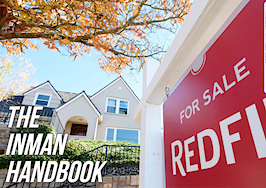Listing agents have to work through a plethora of situations and have many uncomfortable conversations with a variety of homesellers. Ideally, sellers rely on their agent’s advice to update and declutter their homes before they go on the market.
Agents can provide lists of home and garden fix-ups along with articles outlining things buyers hate, maintenance checklists and simple cosmetic fixes. Onerous as some of these to-do list items may be, most sellers will comply, albeit some more cheerfully than others.
But what’s an agent to do when a potential listing has issues that only interior designers with proven experience in staging (the decorating equivalent of merchandising) can satisfactorily resolve?
Staging-savvy designers can work wonders with dark rooms, spaces that are too small or too large, furniture that’s out-of-scale for the setting, too much furniture, strange floor plans, poor color choices and dowdy design features.
Yet, exactly how does an agent have “the talk” with sellers who view any discussion of decorative changes as an attack on their own taste? And, more importantly, how does an agent convince sellers to spend money to have an unknown designer or stager solve problems they don’t recognize they have?

Breadmaker / Shutterstock
Here are seven pointers to help you navigate those waters.
1. Put yourself in their shoes
All the fix-up and clean-up lists you supply make your seller’s home and garden more useful, beautiful and comfortable for them as well as more appealing to buyers. So, they get to enjoy the results of their expenditures whether their home sells or not.
Staging, conversely, turns their personal space into a depersonalized “model home,” and that’s much less comfortable to witness, to live in and keep up on an on-going basis.
Worst of all, if the house doesn’t sell, homeowners are out the expense, but they don’t get to keep the items rented to them by the stager.
2. Don’t even try to start a conversation about staging without acknowledging their discomfort
Don’t sugarcoat the fact that staging will take several miserable (for them) days. Be upfront about the house looking much worse before it looks better while it’s being staged.
Because of that, encourage sellers to leave town during staging. At a minimum, ask that they leave the house while the stager is working. Sellers, by and large, don’t have a clue how staging works, but that never keeps them from offering opinions.
And designers have a low tolerance for sellers who hang around providing commentary while they’re trying to work. So, do all parties a favor and keep sellers and stagers apart.
3. Make sure the seller understands that a stager’s purpose is very different from an interior designer’s usual work
The typical designer wants to make a home livable for the residents.
A stager’s goal, on the other hand, is to emphasize a home’s assets, minimize its less desirable facets and make everything look big, light, bright and open in the photographs that all buyers today see online before they decide to spend time on a personal visit.
Whether that’s comfortable to live in is immaterial. So, usually it’s uncomfortable.
4. Emphasize the financial advantages of having a designer stage their property
Fortunately, the National Association of Realtors has done a ton of studies on the topic of staging and how it pays off.
For example, in a 2015 National Association of Realtors study found, “for every $100 invested in staging, the potential return is $400 … A staged home will sell for 17 percent more on average than a non-staged home, and 95 percent of staged homes sell in 11 days or less. That is statistically 87 percent faster than non-staged homes.”
A 2017 follow-up study conducted by NAR, found among other things that:
- 49 percent of buyer’s agents said that staging had a positive effect on most buyers’ outlook on the home
- 77 percent of buyer’s agents said that home staging helped buyers visualize themselves in the home
- 29 percent of sellers’ agents reported an increase of 1 percent to 5 percent of the dollar value offered by buyers when staging, in comparison to similar homes; 21 percent said that staging a home increased the home’s dollar value by 6 percent to 10 percent
- 39 percent of sellers’ agents stated that home staging greatly decreases the length of time a home is on the market
5. Report your own experience with staging’s impact on time on the market as well as price
Sellers truly believe they will be able to tolerate their home’s lingering on the market for weeks if that’s what it takes to get their desired price.
In actual practice, their anxiety starts to build after the first week. And the person they blame when a property lingers on the market is their agent.
So, listing agents have a stake in getting that listing sold as quickly as possible, too. Happily, a quick offer is also the highest and best offer most of the time.
6. The ROI for listing agents isn’t a higher commission
Whatever the listing agent’s commission, the increase in selling price will never produce the ROI for the agent that it will for the seller. (At 3 percent, a property would have to sell for about $33,500 more than its unstaged equivalent to produce an extra $1,000 in commission for the listing agent.)
But time is money to agents. So, while taking on any part of the staging bill isn’t about monetary gain, a faster sale and happier clients is an undeniable reward.
Depending on the client, you may expect them to foot the entire bill, to split the cost of staging with the seller or even pay for all of it yourself if the stager will simply be rearranging existing furnishings and ensuring that all rooms look great in the photographs.
7. Finally, consider your cost if a seller decides not to stage
If the seller is willing to price the property at a low market rate and the listing is in a desirable area, it may be worth taking the listing as is if they agree to do basic decluttering and refreshing.
But if there’s anything about the property that will make it a harder sale without staging, the best strategy may be referring them to another agent and walking away with an eventual referral fee — or having disappointed clients return to you wiser and ready to stage!
It’s critical to really consider all the angles of staging and to have that conversation with your sellers. Hopefully, these pointers will help you sell your clients on the idea of staging if it’s necessary to a sale.
Nicole Solari is owner and managing broker of The Solari Group in Solano and Napa Counties in Northern California. Nicole runs one of the highest producing brokerages in all of Northern California.







